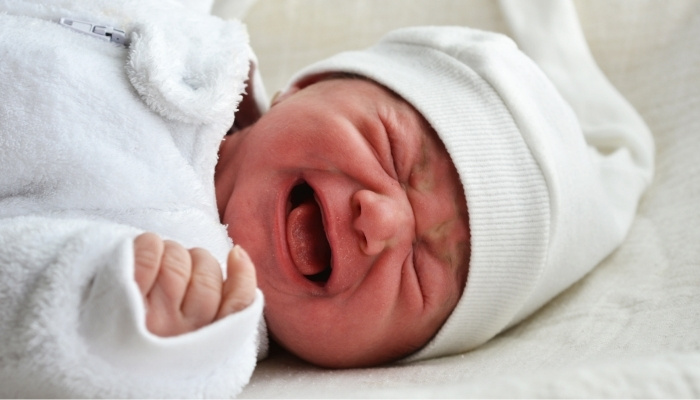Usually, when a baby tightens their legs while being changed, it is just their way of expressing their displeasure towards the expected discomfort of being exposed to cold air and a cold baby wipe.
This is a very normal thing for babies to do as they are discovering new muscles and learning new ways to react to the world around them and to communicate frustration, pain, and excitement.
Bracing for diaper changes is typically no cause for concern, but the Cleveland Clinic reminds parents that the following symptoms might indicate a serious issue:
- Decreased range of motion
- Difficulty moving arms, legs, or neck
- Loss of balance and frequent falls
- Limited joint movement and very little flexibility
- Throbbing pain or soreness in muscles
- Involuntary muscle twitching or jerking
Table of Contents
Stiff Legs During Diaper Changes
One of the primary reasons that babies stiffen their legs during diaper changes is because it is a frustrating, uncomfortable time for them.
Their legs get cold, they don’t like having their legs picked up, and they anticipate the coldness of the baby wipe.
As a reaction to this discomfort and in an effort to communicate their frustration, babies will often stiffen their legs when undergoing a diaper change.
This is completely normal.
Stiff legs are not the only frustrating thing that babies do during diaper changes.
Once babies become more mobile and develop a greater sense of independence, diaper changes become even more dreadful for them because they are temporarily limited in their ability to move around and be independent.
They express this frustration in other ways such as:
- Twisting, turning, or rolling
- Kicking
- Crying and fussing
How To Make Diaper Changes Easier
If diaper changes are getting progressively more difficult, there may be some things you can do to make it a bit more enjoyable.
Try a few of these tips:
- Sing to your baby.
- Give your baby a toy to play with.
- Make noises and play with your baby while you change their diaper. Blow tummy raspberries, tickle, and play.
- Have the clean diaper ready to go under the dirty one in order to make the change quick and seamless (unless you’re dealing with a diaper blowout).
My oldest child started stiffening her legs (and rolling away) when she was around 9 months old.
She knew a diaper change was imminent, and she wanted no part of it!
I found that distraction was the best way to win the diaper battle.
Letting her hold a small mirror or one of her favorite toys usually gave me enough time to get the job done.
When To Be Concerned
Stiffening of the legs during diaper changes is a very common and normal thing that babies do.
It is simply one of their means of communicating frustration, pain, discomfort, or excitement. It is not usually a cause for concern.
However, if the stiffness exceeds temporary moments of pain or frustration and begins to hinder your baby’s ability to move, then it may be time to see a professional.
Also, if your baby is not meeting milestones as expected, you should consult with their pediatrician.

Should You Lift Baby’s Legs To Change Diapers?
The typical, double-leg lift to change a baby’s diaper can actually put a lot of stress on their lower back and contribute to digestive issues.
Baby and toddler developmental specialists say that the best thing you can do is roll your baby from side to side during diaper changes to protect their spine.
Other Times Your Baby May Stiffen Legs and Arms
It is common for babies to stiffen when they are frustrated about something, uncomfortable, or in pain.
Teething, being put into the car seat, or not being able to do something they want to do are examples of such instances.
However, the opposite is also true, and they may stiffen when they are excited, such as when they are being picked up or see something that makes them happy.
Baby Stiffens Legs and Arms and Grunts
Grunting is a very common thing that babies do for a variety of reasons. It is often paired with stiffening of the legs and arms as well.
Grunting is not usually a cause for concern. Most often, babies will grunt and stiffen their arms and legs in the following instances:
- Trying to pass stool.
- Reflux or GERD, particularly in newborns.
- Situations where they are frustrated about something (diaper changes, being put in the car seat, etc.).
- Excitement or to gain a reaction from others.
If you notice that your baby’s grunts seem to be accompanied by a lot of pain or something really doesn’t seem right, always reach out to a medical professional.
Baby Stiffens Body and Cries
Crying is a completely healthy and normal behavior for babies.
Particularly in the first several months to the first year of their lives, crying is a baby’s way of communicating their needs to their parents.
A newborn infant will often cry because they are experiencing mild pain from something like gas or being held in an awkward position.
In a small number of cases, crying accompanied by stiffening and an arched back is a sign of more serious problems such as spastic cerebral palsy or other birth injuries.
However, this is very rare.
Baby Stiffens Body When Picked Up
Most of the time, a baby will stiffen while being picked up out of anticipation and excitement.
Researchers have found that a newborn baby can sense when their mother is about to pick them up and will stiffen in preparation.
In most cases, this is normal behavior.
Hypertonia in Babies
If you have noticed that your baby is unusually stiff, so much that it impedes their ability to move around, or if your baby’s muscles feel tight to the touch, seek medical attention to determine if your baby has a condition called hypertonia.
Hypertonia Explained
When we move our limbs, our muscles contract and relax. Muscle tone is the amount of tension, or resistance to movement, in our muscles.
Hypertonia is when a baby’s muscle tone is too high. Because of this, their muscles are constantly contracting, remaining tight, and resisting movement.
Basically, when a baby has hypertonia, they are unable to relax their muscles and they remain in a state of contraction.
Hypertonia can be congenital, or it could be the result of a brain or spinal cord injury, usually during birth. It is usually diagnosed before the age of two.
Hypertonia Symptoms
Hypertonia causes babies to move differently due to a limited range of motion in the joints.
This can make the symptoms easy to spot because your baby’s movements will not look normal.
If you are concerned about hypertonia, look for the following symptoms:
- Difficulty moving arm, leg, and neck muscles
- Robotic movements because of limited motion in the joints and an inability to relax muscles
- Poor balance and falling
- Limited joint movement and flexibility
- Involuntary muscle twitching or jerking
Mild Hypertonia in Babies
There are a few different types of hypertonia that will affect babies differently and have different outcomes.
- Spasticity describes a type of hypertonia that is characterized by muscle spasms and exaggerated reflexes during movement.
- Rigidity is hypertonia that is characterized by stiffness even without movement. In these cases, babies are always unusually stiff.
The severity of hypertonia can also vary.
Some babies may have very mild hypertonia characterized by moderate stiffness and difficulty moving as other babies do.
Mild hypertonia often improves over time and with treatment.
Hypertonia Treatment
If detected early enough, hypertonia can often be treated. Mild cases of hypertonia are often treated with physical therapy and stretching exercises.
Massages, joint compressions, and practicing normal movements are also common parts of treatment.
Sometimes, casting a muscle is necessary in order to stretch it out for a period of time and create a greater range of motion.
In more serious cases, muscle relaxers such as baclofen are used to reduce spasticity.
Hypertonia is a lifelong condition; however, depending on the severity, it can improve over time with treatment.
The treatment aims to reduce symptoms and improve muscle function.
The timeline or extent of symptoms improving depends on the severity and cause of the diagnosis.
Is Hypertonia the Same as Stiff Baby Syndrome?
Hypertonia is different from stiff baby syndrome.
Stiff baby syndrome is a genetic disorder known as hyperekplexia in which babies have an exaggerated startle reflex.
Babies with this disorder will have extreme reactions to loud noises and unexpected movements or touches.
These reactions can range from eye blinking and spastic jerking movements to falling stiffly to the ground.
Hypertonia and stiff baby syndrome are often confused because both involve rigidness and stiffness in babies.
However, they are different, and hypertonia is often a byproduct of stiff baby syndrome.
Signs of Cerebral Palsy in Children
The main symptoms of cerebral palsy are problems with movement, coordination, and development.
Possible signs may include:
- Delays in reaching movement milestones, such as not walking by 18 months or sitting by 8 months
- Walking on tiptoes
- Seeming too stiff
- Weak arms or legs
- Random, uncontrolled movements
If your child is not reaching their milestones or exhibiting any of these symptoms, it is important to consult their pediatrician.
Infantile Spasms
Infantile spasms, also known as West syndrome, is a rare and severe form of epilepsy that typically affects infants in their first year of life, usually appearing between 3 and 8 months of age.
These spasms are characterized by brief, symmetric muscle contractions that often involve the neck, trunk, and extremities.
The spasms may look like a sudden, jerking motion or a brief flexion of the body.
Infantile spasms can be challenging to diagnose because the movements may be subtle, and they often occur in clusters.
In addition to the spasms, babies with West syndrome may also exhibit developmental regression, where there is a loss of previously acquired developmental skills.
The causes of infantile spasms can vary but include structural brain abnormalities, genetic factors, and metabolic disorders.
In some cases, the cause may not be identified.
Early diagnosis and intervention are crucial because prompt treatment may improve outcomes and reduce the risk of long-term developmental problems.
Treatment for infantile spasms typically involves medications, such as adrenocorticotropic hormone (ACTH) or oral steroids, which aim to control the seizures.
Other antiepileptic drugs may also be used, depending on the underlying cause.
Tonic Seizures in Babies
Tonic seizures may manifest as sudden stiffening of the muscles, typically involving the arms, legs, or trunk.
The baby may appear rigid, and the episode is usually brief but can be concerning for parents or caregivers.
It’s important to note that seizures can have various causes, and not all instances of muscle stiffness in babies are necessarily tonic seizures.
Seizures in infants can be associated with underlying neurological conditions, genetic factors, or other medical issues.
Mom of three (including identical twin boys), wife, and owner of Parents Wonder. This is my place to share my journey as a mother and the helpful insights I learn along the way.

